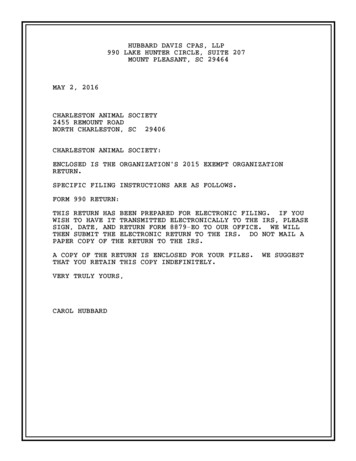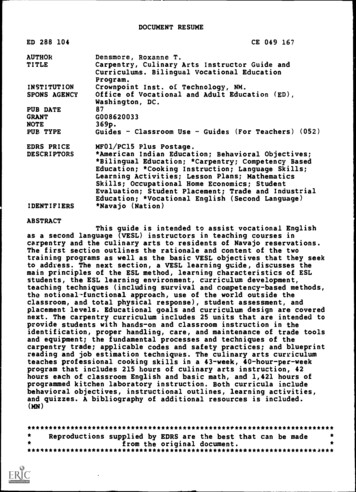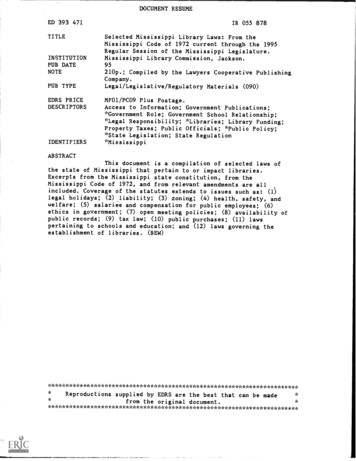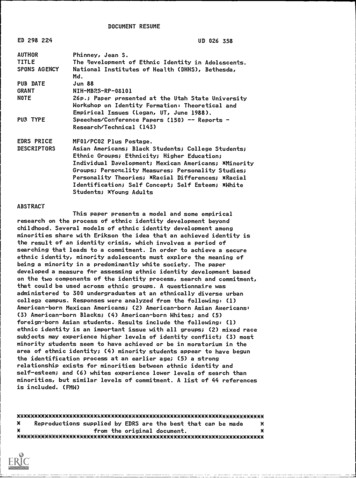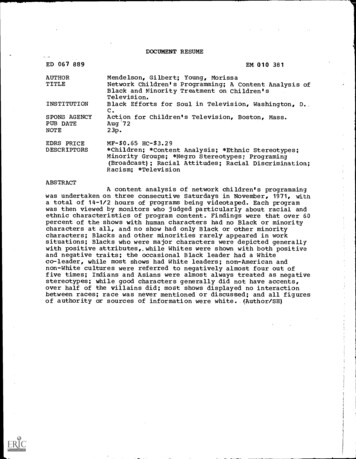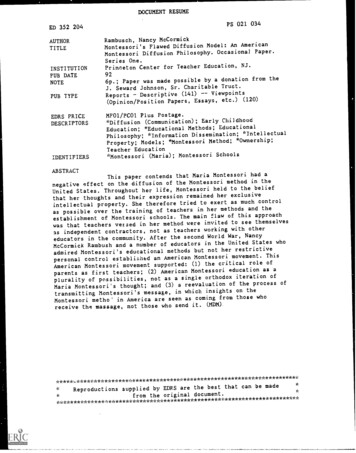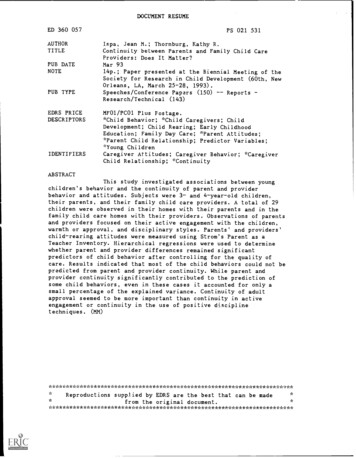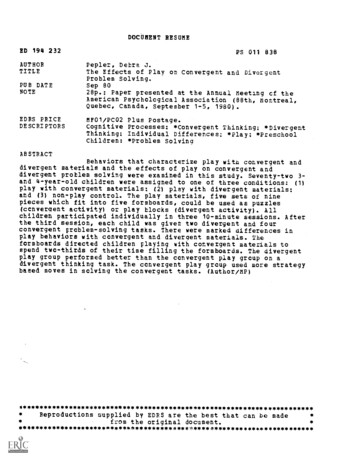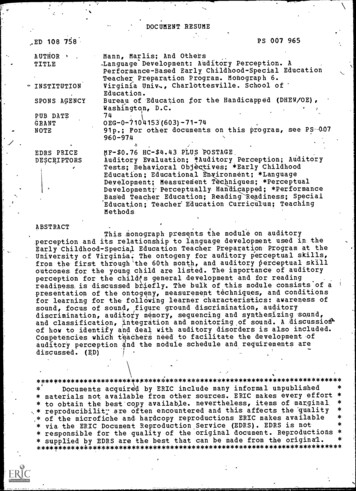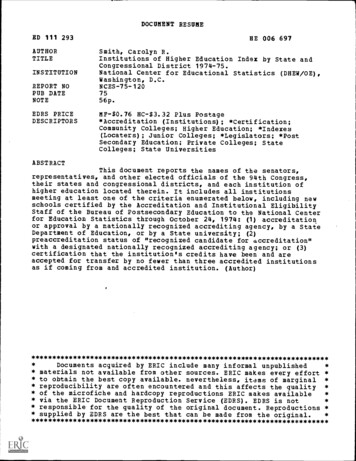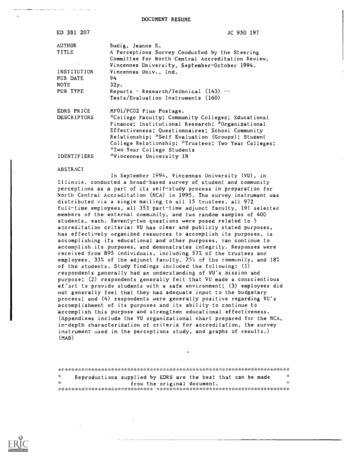
Transcription
DOCUMENT RESUMEED 381 207AUTHORTITLEINSTITUTIONPUB DATENOTEPUB TYPEJC 950 197Budig, Jeanne E.A Perceptions Survey Conducted by the SteeringCommittee for North Central Accreditation Review,Vincennes University, September-October 1994.Vincennes Univ., Ind.9432p.ReportsResearch/Technical (143)Tests /Evaluation Instruments (160)EDRS PRICEDESCRIPTORSMF01/PCO2 Plus- Postage.*College Faculty; Community Colleges; EducationalIDENTIFIERSFinance; Institutional Research; *OrganizationalEffectiveness; Questionnaires; School CommunityRelationship; *Self Evaluation (Groups); StudentCollege Relationship; *Trustees; Two Year Colleges;*Two Year College Students*Vincennes University INABSTRACTIn September 1994, Vincennes University (VU), inIllinois, conducted a broad-based survey of student and communityperceptions as a part of its self-study process in preparation forNorth Central Accreditation (NCA) in 1995. The survey instrument wasdistributed via a single mailing to all 15 trustees, all 972full-time employees, all 353 part-time adjunct faculty, 191 selectedmembers of the external community, and two random samples of 400students, each. Seventy-two questions were posed related to 5accreditation criteria: VU has clear and publicly stated purposes,has effectively organized resources to accomplish its purposes, isaccomplishing its educational and other purposes, can continue toaccomplish its purposes, and demonstrates integrity. Responses werereceived from 895 individuals, including 57% of the trustees andemployees, 33% of the adjunct faculty, 25% of the community, and 18%of the students. Study findings included the following: (1)respondents generally had an understanding of VU's mission andpurpose; (2) respondents generally felt that VU made a conscientiouseCort to provide students with a safe environment; (3) employees didnot generally feel that they had adequate input to the budgetaryprocess; and (4) respondents were generally positive regarding VU'saccomplishment of its purposes and its ability to continue toaccomplish this purpose and strengthen educational effectiveness.(Appendixes include the VU organizational chart prepared for the NCA,in-depth characterization of criteria for accreditation, the surveyinstrument used in the perceptions study, and graphs of results.)(MAB)*i.-**************************:. ons supplied by EDRS are the best that can be madefroni the original ***************************
A PERCEPTIONS SURVEYCONDUCTED BY THE STEERING COMMITTEEFOR NORTH CENTRAL ACCREDITATION REVIEWU S DEPARTMENT OF EDUCATIONwine or Efl,raio d, Flesnwr, 4,0 ,T,rVINCENNES UNIVERSITYEDUCATIONAL RESOURCES INFORMATIONCENTER (EMIZINs documenthas been reproduced as-PERMISSION TO REPRODUCE THISMATERIAL HAS BEEN GRANTED BYiecolved from the person or organizationoriginating itJ. Budig0 Minor changes have been made toonprove reproduction qualityPoints at view or opinions stated in thisdocument do not necessarily representotticat 0511 position or policySeptember-October 1994c--cy-TO THEEDUCATIONAL RESOURCESINFORMATION CENTER IERICIDesigned, Analyzed, and Described byJeanne E. Budig, Ph.D.Assistant to the President for Research and PlanningVincennes UniversityVincennes, IN 47591812-888-4377email jbudig@vunet.vinu.edu
A VINCENNES UNIVERSITYPERCEPTIONS SURVEYAbstract: In Septe nber 1994 Vincennes University designed and conducted a Perceptions Surveyas an integral part of its self-study process in preparation for North Central Accreditation in 1995.This paper describes the survey and its analysis.BackgroundFounded in 1806, Vincennes University is Indiana's oldest comprehensive two-yearcollege. The North Central accreditation process requires the preparation of a comprehensiveSelf-Study which candidly examines and discusses the institution's strengths and challenges. Itwas decided to conduct a broad-based Perceptions Survey of the entire University community as acentral focus point for the Self-Study.The President appointed a self-study Coordinator, Professor James Messmer; a SteeringCommittee; a Writing Committee; and twelve task forces (See Appendix One.) The Coordinatorprovided the Steering Committee with copies of Perceptions Surveys recently used by otherinstitutions. The Steering Committee also considered using the NCHEMS Institutional Performance Survey for two-year colleges, but elected instead to develop a survey in-house that wastailored to the specific characteristics of Vincennes University.Each of eleven task forces was asked to develop about six questions which would providetheir committee with evidence that Vincennes University was meeting the five criteria foraccreditation (Appendix Two) appropriate to their area of concern. The result was a 72-item23
survey which would solicit Likert scale responses. "Undecided" was a response separate from"Don't Know or "Not Applicable." (Appendix Three).Sample Selection and Response RateThe survey was printed on salmon-colored paper (to control for multiple submissions) anddistributed to all Trustees (N 15), all V.U. Full Time Employees (N 972); all part-time adjunctfaculty (N 353); selected members of the external community (N 191, selected by the Presidentand Coordinator based on their affiliations with Vincennes University and/or leadership role in thecommunity) and two random samples of students, 400 living on-campus and 400 off-campusstudents. A single mailing and no follow-up, other than electronic and news reminders from thePresident, was conducted. The response rate was just under 57% from trustees and employees,33% from adjunct faculty, just under 25% from the community, and less than 18% from students.Survey AnalysisSurvey demographic characteristics and responses were entered into a data file and crosstabulations of responses by "Person" (box I), "Site" (Box 2), years of affiliation (less than 1 year,2-5 years, 6-10 years, 10 years) and current affiliation (both Box 3) were determined by SAS.The seventy-two questions were then aggregated according to the five North CentralAccreditation Criteria: Criterion I, Q. 1-3; Criterion II, Q. 4-38; Criterion ELI, Q. 39-63;Criterion IV, Q 64-68; and Criterion V, Q. 69-72. The spreadsheet matrix which had been thesurvey instrument (Appendix Three) was reorganized to show survey results (See AppendixFour).Actual counts were manually entered on the "analysis" spreadsheet, and a weighted Indexwas generated: "Strongly agree" responses were given a weight of 2; "Agree" 1, "Disagree"34
-1, "Strongly Disagree" -2; "Undecided" and "Don/t Know/Not Applicable" were assigned aweight of zero. The index was the sum of the weights divided by the total number ofrespondents less than number of '0' weights. The index, therefore, represents the weightedopinion (perception) of all of those respondents who had a decided opinion on this item.The resultant indices were automatically copied in a bargraph for this criterion whichsummarily showed the "Response Index" as, on the whole, "Positive" or "Negative." The lengthof the bar suggests the relative strength of the perception. Because there were many "don'tknow" responses on several questions, it was deemed important to note, on the left axis of eachgraph, how many respondents this particular answer represents.In addition to the "All Responses" analysis provided in this study, eighteen moresub-group analyses were prepared. These nineteen analyses are listed in Appendix Four.Use and Distribution and Use of Survey ResultsFindings of the Perceptions Survey were widely distributed. Separate packets wereprepared for each of the eleven task forces of responses, from all nineteen of the analyses, to thespecific questions this task force had asked. Sub-group analyses were given to specific groups:Faculty responses to the Faculty Senate; Professional Staff to their campus organization. Twocopies of all analyses (Volume I and Volume II) were placed in the Learning Resources Center.The entire data base was made available on diskette for whomever wanted to analyze it further.The most important outcome of this effort was that findings of the Perceptions Surveywere cited repeatedly throughout the final Self Study Document.4J
ckV-ChairBrendaRigginsSteveChaoCriterion #5InstitutionalIntegrityCriterion #4ServicesAssessmentCriterion #3Planning& sChair, Mary Lee BowmanWRITING arquezStudentFinancial1ISTEERING COMMITTEEISELF-STUDY COORDINATORPRESIDENTBOARD OF TRUSTEESBEST COPY AVAILABLEV-ChairHaroldJackHanesChairCriterion icalResourcesV NCENNES UNIVERSITYSelf-Study & Ten-Year ReacereditationOrganizational ChartV-ChairWalterChairCriterion TI IPurposesChair& GIRs1486ResponseHistoryAppendix One
Appendix TwoNORTH CENTRAL ASSOCIATIONCOMMISSION ON INSTITUTIONS OF HIGHER EDUCATIONThe Criteria for Accreditation'CRITERION ONE. The institution has dear and publicly stated purposes consistent with its mission andappropriate to an institution of higher education.In developing the pattern of evidence supporting this criterion, the Commission suggests the breadth ofevaluation that it considers appropriate to this foundational criterion:A. long- and short-range institutional and educational goals.B. processes, involving its constituencies, through which the institution evaluates its purposes.C. decision-making processes that are appropriate to its stated mission and purposes.D. understanding of the stated purposes by institutional constituencies.E. efforts to keep the public informed of its institutional and educational goals through documents suchas the catalog and program brochures.F. support for freedom of inquiry for faculty and students.G. institutional commitment to excellence in both the teaching provided by faculty and the learningexpected of students.CRITERION TWO. The institution has effectively organized the human, financial, and physical resourcesnecessary to accomplish its purposes.In determining appropriate patterns of evidence for this criterion, the Convnission considers evidence such as:A. governance by a board consisting of informed people who understand their responsibilities, function inaccordance with stated board policies, and have the resolve necessary to preserve the institution'sintegrity.B. effective administration through well - defined and understood organizational structures, policies, andprocedures.C. qualified and experienced administrative personnel who oversee institutional activities and exerciseappropriate responsibility for them.D. systems of governance that provide dependable information to the institution's constituencies and, asappropriate, involve them in the decision-making processes.E. faculty with educational credentials that testify to appropriate preparation for the courses tiiey "each.F. a sufficient number of students enrolled to meet the institution's stated educational purposes.G. provision of services that afford all admitted students the opportunity to succeed.H. a physical plant that supports effective teaching and learning.I.conscientious efforts to provide students with a safe and healthy environment.J. academic resources and equipment (e.g., libraries, electronic services and products, learning resourcecenters, laboratories and studios, computers) adequate to support the institution's purposes.K. a pattern of financial expenditures that shows the commitment to provide both the environment andthe human resources necessary for effective teaching and learning.L. management of financial resources to maximize the institution's capability to meet its purposes.CRITERION THREE. The institution is accomplishing its educational and other purposes.In developing the pattern of evidence supporting this criterion, the Commission suggests the breadth of reviewthat it considers appropriate:educational programs appropriate to an institution of higher education.assessment of appropriate student academic achievement in all its programs, documenting:proficiency in skills and competencies essential for all college-educated adults;completion of an it -affable and coherent undergraduate level general education component; andmastery of the level of knowledge appropriate to the degree granted.8C. transcripts that accurately reflect student learning and follow commonly accepted practices.A.B.
D.E.F.G.H.effective teaching that characterizes its courses and academic programs.ongoing support for professional development for faculty, staff, and administrators.student services that effectively support the institution's purposes.staff and faculty service that contributes to the institution's effectiveness.if appropriate:evidence of support for the stated commitment to basic and applied research through provision ofsufficient human, financial, and physical resources to produce effective research;evidence of support for the stated commitment to the fine and creative arts through provision ofsufficient human, financial, and physical resources to produce creative endeavors and activities;evidence of effective delivery of educational and other services to its community;evidence of development and offering of effective courses and programs to meet the needs of itssponsoring organization and other special constituencies.CRITERION FOUR. The institution can continue to accomplish its purposes and strengthen its educationaleffectiveness.In determining appropriate patterns of evidence for this criterion, the Commission considers evidence such as.a current resource base -- financial, physical, and human - -that positions the institution for the future.decision-making processes with tested capability of responding effectively to anticipated andunanticipated challenges to the institution.structured assessment processes that are continuous, that involve a variety of institutionalconstituencies, and that provide meaningful and useful information to the planning processes as wellas to students, faculty, and administration.plans as well as on-going, effective planning processes necessary to the institution's continuance.resources organized and allocated to support its plans for strengthening both the institution and itsprograms.A.B.C.D.E.CRITERION FIVE. The hoditation demonstrates integrity in its practices and relationships.In determining appropriate patterns of evidence for this criterion, the Commission considers evidence such as:A.B.C.D.E.F.G.H.1student, faculty, and staff handbooks that describe various institutional relationships with thoseconstituencies, including appropriate grievance procedures.policies and practices for the resolution of internal disputes within the institution's constituency.policies and practices consistent with its mission related to equity of treatment, non-discrimination,affirmative action, and other means of enhancing access to education and the building of a diverseeducational community.institutional publications, statements, and advertising that describe accurately and fairly the institution,its operations, and its programs.relationships with other institutions of higher education conducted ethically and responsibly.appropriate support for resources shared with other institutingpolicies and procedures regarding institutional relationships .tad responsibility for intercollegiateathletics, student associations, and subsidiary or related business enterprises.oversight processes for monitoring contractual arrangements with government, industry, and otherorganizations.Handbook of Accreditation, 1994-95, Working Draf t.
Vincennes UniversityAAppendix ThreeTs%TO:Members of the Vincennes University CommunityFROM:Jim Messmer, Self Study CoordinatorSUBJECT:Perceptions SurveyDATE:September 6, 1994Enclosed you will find the Perceptions Survey I spoke about at the Opening Meeting oh August15th. This instrument represents your opportunity to provide input into the perceived strengthsand areas for improvement of Vincennes University for the North Central Self-Study. The surveyis designed to provide information on the perceptions about the overall institution rather thanabout any one department or program.On behalf of the Steering Committee. I ask you to complete this confidential survey in an openand honest manner.Please complete the survey as soon as possible and return it in the envelope provided bySeptember 20th.Thank you in advance for your participating in the Self-Study Process.10
VINCENNES UNIVERSITY PERCEPTIONS SURVEYCONDUCTED BY THE SELF-STUDY STEERLIG COMMITTEESEPTEMBER 1994BY: (Please check ONE)Site:TrusteeYears of Affiliation withV.U.:Vincennes/VincennesCampusVice President or DeanCurrent Affiliation with V.U.:Professional StaffJasper, Ft. Benjamin Hamson, Av. TechnologyCenter or Indiana Schoolfor the DeafSupport StaffAdjunct Faculty/Staff atFacultyFull Time EmployeePart Time EmployeeStudent, Trustee, orCommunity MemberRemote LocationsStudentCommunity MemberCommunity Services(Indiana)your open on onIZarc7illmfollowing statements by checking the appropriate box:StronglyAgree1. Questions about Mission, Purpose, and Governance:1. From my perspective as employee, student. communitymember or trustee, I understand Vincennes Univentrtysmission and purposes as stated In the V, U. Catalog.2. Vincennes University promotes the expansion andopening of students' minds.3. Providing developmental education for those studentswho need it is a valid part of Vincennes Universitysmission and purpose.4 V.U. has a strong and effective Board of Trustees.5. The process by which Trustees are appointed resultsin a body which is balanced and represents theeducational interests of the State of Indiana.6. The University promoted widespread involvement andparticipation in the design and implementation ofthe new governance structure.7. For the most pert, University policies and proceduresare clearly defined and understood as stated in theUniversity Manual.8. With its new governance structure, the University ismoving in the right direction.9. Pertinent information is communicated to Universityemployees in a timely and appropriate manner.10. The University encourages employee participationin planning, procedures, and policy development.Vincennes University has in place well-defined andunderstood organizational structures, policies. andprocedures11BEST COPY AVAILABLE1Un-AgreedecidedAgreeStrongly Don't KnowDisagree or NotApplicably
VINCENNES UNIVERSITY PERCEPTIONS SURVEYCONDUCTED BY THE SELF-STUDY STEERING COMMITTEESEPTEMBER 199404StronglyAgra.dsciz'ortAgreeQusationa oho Human, Physical, and Financial Resources:12. Policies and procedures related to job classification,compensation, workle. promotion, tenure, andreduction in force are clear and consistent for allUniversity personnel.13. The institution provides adequate support (financialresources, release time, encouragement) for professional growth of individual faculty and staff members.! feel comfortable expressing a complaint or legitimate objection to my Immediate supervisor.14.15. The institution provides faculty and staff with anadequate number of in -house seminars and workshops,including computer training, for professional development.16. Evaluation of all personnel, including administration,faculty, professional staff, and support staff, Is consistentand clear.17. There is no discrepancy between genders in mattersof appointment, pay, and tenure.18 Vincennes University has facilities that supporteffective teaching and learning.19. Vincennes University makes conscientious effortsto provide students with a safe and healthy environment.(i.e., securit
IDENTIFIERS *Vincennes University IN. ABSTRACT. In September 1994, Vincennes University (VU), in Illinois, conducted a broad-based survey of student and community perceptions as a part of its self-study process in preparation for North Central Accreditation (NCA) in 1995. The survey inst
